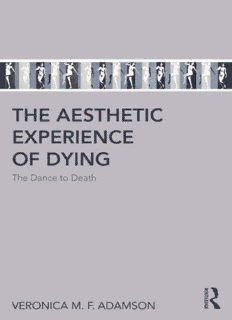
The Aesthetic Experience of Dying: The Dance to Death PDF
Preview The Aesthetic Experience of Dying: The Dance to Death
THE AESTHETIC EXPERIENCE OF DYING Structuredaroundapersonalaccountoftheillnessanddeathoftheauthor’spartner, Jane, this book explores how something hard to bear became a threshold to a world of insight and discovery. Drawing on German Idealism and Jane’s own research in the area, The Aesthetic Experience of Dying looks at the notion of life as a binary synthesis, or a return enhanced, as a way of coming to understand death. Binary synthesis describes the interplaybetweendynamicallyopposingpairsofconcepts–suchaslifeanddeath– resultinginanenhancedversionofoneofthemtomoveforwardinanewcycleof the process. Yet what relevance does this elegant word game have to the shocking diagnosis of serious illness? Struggling to balance reason with sense, thought with feeling,this bookexaminestheexperienceofcaringforsomeonefrom diagnosisto death and is illustrated with examples of the return enhanced. The concluding chapter outlines how the tension of Jane’s dying has been resolved as the rhythmic patternsofthelifeworldhavebeenunderstoodthroughtheprocessofreflectingon the experience. This creative and insightful book will appeal to those interested in the medical humanities. It will also be an important reference for practising and student health professionals. Veronica M. F. Adamson is an Honorary Fellow in the School of Health in Social Science, University of Edinburgh, UK. ‘Thisisabeautiful,visceralandnotleastcourageoustextthatopensthereadertothe depths and details of a human life facing death. Adamson succeeds in offering a poignant reflection that journeys from diagnosis to death in a way that is faithful to the shared depths of the lifeworld. As such, she generously provides a moving and insightfulnarrativeforcontemplationaboutwhatitistobehumanandthenatureof the lifeworld in living towards death.It should be read byall professionally involved interminalillness,itspansinsightsintowell-being,aestheticdimensionsofillnessand the implicit splits between reductionist approaches in care delivery and human embodiment which are all skilfully revealed and grasp the human heart.’ Kathleen Galvin, University of Brighton, UK THE AESTHETIC EXPERIENCE OF DYING The Dance to Death Veronica M. F. Adamson Firstpublished2018 byRoutledge 2ParkSquare,MiltonPark,Abingdon,OxonOX144RN andbyRoutledge 711ThirdAvenue,NewYork,NY10017 RoutledgeisanimprintoftheTaylor&FrancisGroup,aninformabusiness ©2018VeronicaM.F.Adamson TherightofVeronicaM.F.Adamsontobeidentifiedasauthorofthisworkhas beenassertedbyhim/herinaccordancewithsections77and78ofthe Copyright,DesignsandPatentsAct1988. Allrightsreserved.Nopartofthisbookmaybereprintedorreproducedor utilisedinanyformorbyanyelectronic,mechanical,orothermeans,now knownorhereafterinvented,includingphotocopyingandrecording,orinany informationstorageorretrievalsystem,withoutpermissioninwritingfromthe publishers. Trademarknotice:Productorcorporatenamesmaybetrademarksorregistered trademarks,andareusedonlyforidentificationandexplanationwithoutintentto infringe. BritishLibraryCataloguinginPublicationData AcataloguerecordforthisbookisavailablefromtheBritishLibrary LibraryofCongressCataloginginPublicationData Acatalogrecordforthisbookhasbeenrequested ISBN:978-1-138-63522-7(hbk) ISBN:978-1-138-63524-1(pbk) ISBN:978-1-315-20648-6(ebk) TypesetinBembo byTaylor&FrancisBooks For Jane, with love This page intentionally left blank CONTENTS Acknowledgements viii Introduction ix 1 The return enhanced 1 2 Invitation to the dance 43 3 Days for dancing 76 4 The last waltz 116 5 The aesthetic experience of dying 147 Index 189 ACKNOWLEDGEMENTS Writing a book is a solitary task which can lead the author to believe it is solely their unaided achievement. On one level this is true but then there is the network of supporters, encouragers, reviewers and commentators without whom we writers would be a dull and arrogant bunch. So without further ado there are some very important persons, in no particular order, whom I must both acknowledge and thank most sincerely. My wonderful and amazing family – Rose, Sylvain, Wilf and Gélise – are always there to cheer me through the dark, damp bits. Without Margaret, there would have been no Jane and I value greatly her support and friendship. Jane would be so pleased that I continue to dine with her school friends, Anne, Alison and Susan; I am truly grateful for their continuing support and encouragement. Clodagh Ross provides compassion and friendship while seeking clarity to my obfuscations. My research supervisors, Professor Tonks Fawcett and Dr Marion Smith, guided me when I strayed from the path, as I frequently did, supported my wobbly knees and kept the faith that it could and would be done. The thesis examiners, Dr Rosie Stenhouse and Dr Fiona Cowdell provided apposite com- ments and suggested reworking the text into a more accessible book format. Rev. Dr Harriet Harris has helped me to explore some of the spiritual aspects of death and dying of the study through a conversation series hosted by the University of EdinburghChaplaincy.GraceMcInnesatRoutledgehasprovidedvaluableguidance on the metamorphosis of a thesis into a book. Particular thanks are due to Tonks for her continuing encouragement, draft reviewing and comments especially when she has so many calls on her time. INTRODUCTION The realisation that a loved one may be seriously ill is shocking. When those concernsarethenconfirmedashardfact,theeffectisshattering.Fromthemoment alife-limitingconditionisdiagnosed,lifecan andwillneverbeasit hadbeen. Our reactions to such news and its consequences depend on many factors: who it is, whatiswrongandourrelationshiptothepersonconcerned.Whatwedowiththis new and unwanted knowledge is dependent on our previous experience, our current circumstances and our worldview of disease and its treatment. Having sharedsuchanexperiencewhatthenisworthyofformalresearch?Therearepossibly two reasons for the justification of studying the experience of caring for someone with life-limiting disease: to make sense of it and to discover if there is anything newtocontributetowhatisalreadyknown.Theremayalsobemanyotherfactors interms ofpersonalinterest, unresolved issuesand asenseof something unfinished; fundamentally it is the belief that something might need to be better understood. My partner, Jane, was diagnosed with advanced ovarian cancer in 2011 and died the following May. The time of her illness was one of tension with episodes of intensification as the disease progressed which, for her, was resolved with death. Yet for me there were many questionsand uncertainties about what had happened during those months of illness. While I knew her dying had been as she had wished, at home in her own bed, there seemed to be something more to it that I wanted to understand. Or perhaps Iwas just not yetready to let her go.Jane hada fine brain, was the first inher family to attend university gainingnot just a first but then a PhD. Her doctoral work drew heavily on Goethe and his ideas of seculari- sation as well as the influence of his relationship with Schiller (Plenderleith, 1991). As a result of her own studies she had formed a view that life could be understood as a return enhanced – a way of recognising something that had perhaps been experienced previously but not then fully appreciated. This idea comes from the academic analysis and interpretation of both Schiller’s and Goethe’s style of
Description: